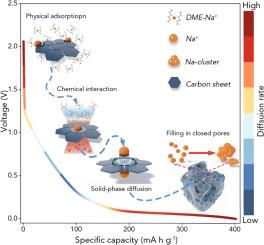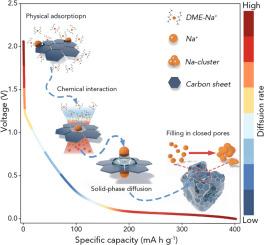无序碳中钠的多级贮存动力学行为
IF 20.2
1区 材料科学
Q1 CHEMISTRY, PHYSICAL
引用次数: 0
摘要
无序碳的结构复杂性和非均质性给阐明其调解机制带来了重大挑战。在此,通过精确控制的气体腐蚀策略,精心制备了具有定制局部结构的无序碳样品,以便我们能够明确地解开这些材料中的钠储存。根据实验结果,提出了“物理吸附-化学相互作用-(固相扩散)-钠簇填充”的多级钠存储模型。这项工作首次强调了“固相扩散”作为一个重要的动力学桥梁的关键作用,它在缺陷位点和官能团饱和时被激活,并控制了封闭孔隙中钠簇形成的初始阶段。此外,我们的研究表明,钠的储存机制与无序碳材料的结构有关,由其缺陷浓度、类型和空间分布决定。研究表明,钠离子电池的无序碳阳极需要在丰富的闭孔和适度的单空位型缺陷之间取得良好的平衡,才能具有良好的容量、倍率性能和初始库仑效率。具有平衡特性的无序碳样品提供了367.1 mA h g-1的高可逆容量,完整的电池在160次循环后达到307.7 Wh kg⁻¹的能量密度,并保持95.1%的容量保留率。该研究促进了对钠离子存储的理解,并为设计下一代高性能钠离子电池碳阳极提供了新的见解。本文章由计算机程序翻译,如有差异,请以英文原文为准。


Dynamic behavior on multi-stage sodium storage in disordered carbon
The structural complexity and heterogeneity of disordered carbons give rise to significant challenges in elucidating the sodiation mechanism in them. Herein, by means of a precisely controlled gaseous corrosion strategy, disordered carbon samples with tailored local structures are prepared elaborately so that we are able to unravel the sodium storage explicitly in such materials. In terms of results, a multi-stage sodium storage model comprising “physical adsorption - chemical interaction –(solid phase diffusion) - sodium cluster filling” is proposed. This work is the first to highlight the critical role of “solid phase diffusion” as an essential kinetic bridge, which is activated upon the saturation of defect sites and functional groups and governs the initial stage of sodium cluster formation within closed pores. Furthermore, our study reveals that sodium storage mechanisms are related to structures of disorder carbon materials, dictated by their defect concentrations, types and spatial distributions. It is demonstrated that a superior disordered carbon anode for a sodium ion battery necessitates an elaborate balance between abundant closed pores and moderate monovacancy-type defects so as to possess good capacity, rate performance and initial coulombic efficiency. With balanced features, the disordered carbon sample delivers a high reversible capacity of 367.1 mA h g-1, and the full cell achieves an energy density of 307.7 Wh kg⁻¹ while maintains 95.1 % capacity retention after 160 cycles. This research advances the understanding of sodium storage and provides new insights for engineering next-generation high-performance carbon anodes for sodium ion batteries.
求助全文
通过发布文献求助,成功后即可免费获取论文全文。
去求助
来源期刊

Energy Storage Materials
Materials Science-General Materials Science
CiteScore
33.00
自引率
5.90%
发文量
652
审稿时长
27 days
期刊介绍:
Energy Storage Materials is a global interdisciplinary journal dedicated to sharing scientific and technological advancements in materials and devices for advanced energy storage and related energy conversion, such as in metal-O2 batteries. The journal features comprehensive research articles, including full papers and short communications, as well as authoritative feature articles and reviews by leading experts in the field.
Energy Storage Materials covers a wide range of topics, including the synthesis, fabrication, structure, properties, performance, and technological applications of energy storage materials. Additionally, the journal explores strategies, policies, and developments in the field of energy storage materials and devices for sustainable energy.
Published papers are selected based on their scientific and technological significance, their ability to provide valuable new knowledge, and their relevance to the international research community.
 求助内容:
求助内容: 应助结果提醒方式:
应助结果提醒方式:


